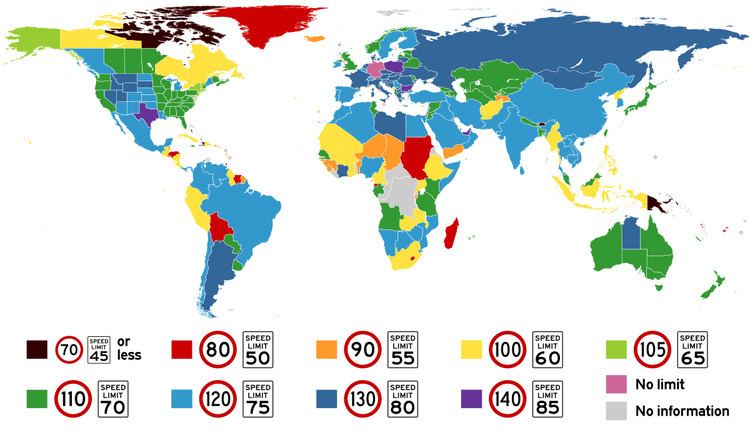 | ||
A road speed limit is the limit of speed allowed by law for road vehicles, usually the maximum speed allowed. Occasionally there is a minimum speed limit. Speed limits are commonly set by the legislative bodies of national or local governments.
Contents
Overview
The following tables show various jurisdictions' default speed limits (where applicable) that apply to different types of vehicles travelling on three different types of road. Actual speed limits may range beyond these values. Speeds are listed in kilometers per hour. The enforcement tolerance is specified in km/h or percentage above the stated limit. For the United Kingdom and the United States, the speed limit is also listed in miles per hour in brackets. Germany, with its Autobahns, is the only country without a general speed limit on its highways. The Isle of Man is the only jurisdiction without a general speed limit on rural two-lane roads.
United States
American interstate highways are frequently patrolled by law enforcement, typically referred to as Highway Patrol, State Patrol or State Police. Speed limit enforcement is the most profitable part of their duty, but other traffic laws are sometimes enforced. Enforcement varies notably between states and traffic conditions. Montana and Nebraska have high tolerance toward speeding. More states are experimenting with variable speed limits, with electronic speed limit displays replacing fixed-number signs. The New Jersey Turnpike and a stretch of Interstate 77 in Virginia has long been equipped with variable-limit signs; in 2011, the same system was put in place along a stretch of Interstate 80 through Wyoming. The idea is to vary speed limits with traffic and weather conditions, the latter being the most immediate concern in Wyoming.
European countries
In some countries in Europe, traffic calming is gradually becoming a regular part of urban traffic management, after a long evolution of opinions and attitudes towards car use and vulnerable road users. From 1980, regulations for 30 km/h zones were enacted and have been widely applied. New urban policies have been defined with a view to encouraging a switch from car use to public transport and non-motorised modes (cycling, walking), with the additional condition of lower speeds to improve safety of vulnerable road users, for example national policies such as Duurzaam Veilig ('sustainable safety') in the Netherlands or "Vision Zero" in Sweden.
